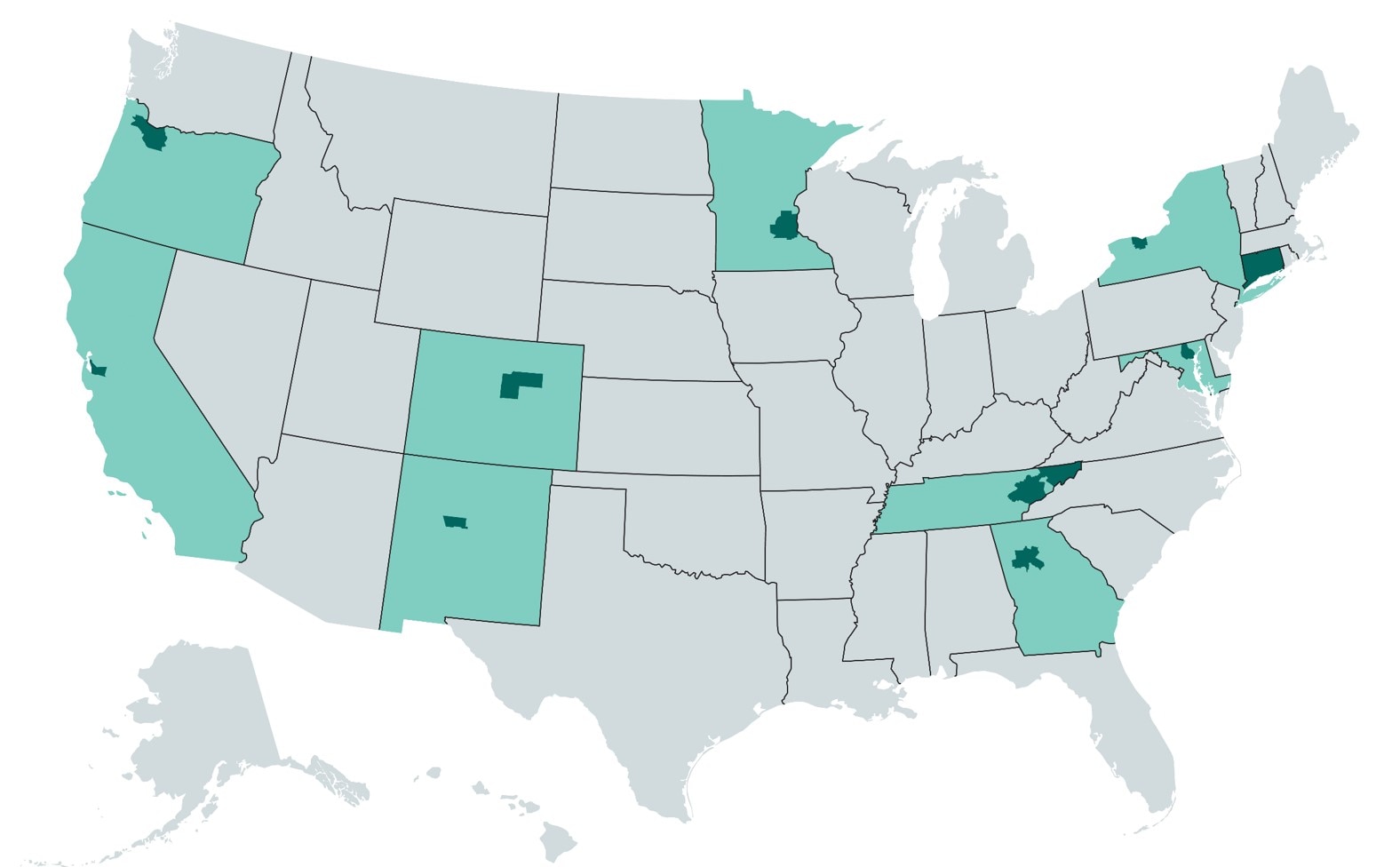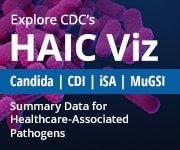Invasive Candidiasis Statistics
How common is invasive candidiasis?
Candidemia is one of the most common bloodstream infections in the United States.1 During 2013–2017, the average incidence (rate of new infections) was approximately 9 per 100,000 people; however, this number varies substantially by geographic location and patient population. CDC estimates that approximately 25,000 cases of candidemia occur nationwide each year.2
Though it is the most common form of invasive candidiasis, candidemia does not represent all forms of invasive candidiasis. The infection can also occur in the heart, kidney, bones, and other internal organs without being detected in the blood. In fact, the number of cases of invasive candidiasis might be twice as high as the estimate for candidemia.
HAICViz is an interactive tool that displays trends in candidemia incidence, outcomes, species distribution, and antimicrobial resistance patterns using data collected through the Emerging Infections Program.
Public health surveillance for candidemia in the United States
Since 2008, CDC has performed continuous, active population-based surveillance for Candida bloodstream infections (candidemia) through the Emerging Infections Program (EIP). EIP is a network of 10 state health departments and their collaborators in local health departments, academic institutions, other federal agencies, public health and clinical laboratories, and healthcare facilities.
Active, population-based surveillance for candidemia is being conducted in 10 EIP sites: California, Colorado, Connecticut, Georgia, Maryland, Minnesota, New Mexico, New York, Oregon, and Tennessee (Figure 1). CDC and its partners recruit laboratories and hospitals serving the counties under surveillance to submit reports of candidemia in patients within the surveillance area.
Learn more about methods used for CDC’s candidemia surveillance through EIP.

Figure 1. Emerging Infections Program sites where candidemia surveillance is being conducted; dark green represents counties under surveillance at each EIP site.
Through this program, CDC monitors epidemiologic trends in candidemia and performs species confirmation and susceptibility testing on all available Candida bloodstream isolates to:
- Track incidence of candidemia and monitor laboratory and epidemiologic trends
- Identify new risk factors for candidemia
- Detect changes in resistance to antifungal agents and communicate these results back to submitting laboratories
- Determine the burden (number of cases, treatment costs, etc.) of infections caused by antimicrobial-resistant Candida species and understand the causes of resistance. Antimicrobial resistance happens when germs like bacteria and fungi develop the ability to defeat the drugs designed to kill them. That means the germs are not killed and continue to grow.
- Identify areas where candidemia prevention and intervention strategies should be focused
CDC also collects data on healthcare-associated infections, including central line-associated Candida infections, through the National Healthcare Safety Network (NHSN), the largest healthcare-associated infection reporting system in the United States.
Candidemia trends in the United States
Although there are notable differences by site, overall candidemia incidence has declined. Candidemia incidence declined during 2008–2013 and then stabilized at approximately 9 cases per 100,000 population per year during 2013–2017.3,4 The observed declines in candidemia during 2008–2013 may be related to healthcare delivery improvements such as those involving catheter care and maintenance.3 Increases in incidence for certain surveillance areas may be due to increases in the number of candidemia cases related to injection drug use, which has recently re-emerged as a risk factor for candidemia.5-7
Demographic trends
Candidemia rates by age group have recently changed. Rates decreased significantly among infants and the elderly during 2009–2012, but have remained more stable since 2012.8,9 The reasons for the decline in candidemia rates in some age groups are not fully understood but might be related to factors such as changes in prophylaxis guidelines and improved infection control practices, such as hand hygiene and catheter care. Among all ages, candidemia rates are approximately twice as high among Black people compared with other races/ethnicities. The differences by race might be due to differences in underlying conditions, socioeconomic status, healthcare access and availability, or other factor.
Learn more about candidemia incidence rates by age group and race.
Trends in species distribution
Up to 95% of all invasive Candida infections in the United States are caused by five species of Candida: C. albicans, C. glabrata, C. parapsilosis, C. tropicalis, and C. krusei. The proportion of infections caused by each species varies by geographic region and by patient population.10 Although C. albicans is still the leading cause of candidemia in the United States, increasing proportions of cases in recent years have been attributed to non-albicans species that are often resistant to antifungal drugs.11-13 Altogether, non-C. albicans species cause approximately two-thirds of candidemia cases in the United States.3,11 In some locations, C. glabrata is the most common species. Since 2015, an emerging species called Candida auris (C. auris) has been an increasing cause of invasive Candida infections in the United States.14
Learn more about Candida species distribution.
Trends in antimicrobial resistance
Some types of Candida are increasingly resistant to the first-line and second-line antifungal medications, such as fluconazole and the echinocandins (anidulafungin, caspofungin, and micafungin). About 7% of all Candida bloodstream isolates tested at CDC are resistant to fluconazole. More than 70% of these resistant isolates are the species C. glabrata or C. krusei.11,15 CDC’s surveillance data indicate that the proportion of Candida isolates resistant to fluconazole has remained fairly constant over the past 20 years.11,16,17 Echinocandin resistance, however, appears to be emerging, especially among C. glabrata isolates. Approximately 3% of C. glabrata isolates are resistant to echinocandins, but the percentage may be higher in some hospitals. This is especially concerning because echinocandins are the first-line treatment for C. glabrata, which already has high levels of resistance to fluconazole.15
Learn more about trends in antimicrobial resistance in Candida spp. isolates.
Deaths due to invasive candidiasis
Invasive Candida infections are often associated with high rates of morbidity and mortality, as well as increased length of hospital stay. CDC’s surveillance data indicate that the in-hospital all-cause (crude) mortality among people with candidemia is approximately 25%. However, because people who develop invasive candidiasis are typically already sick with other medical conditions, it can be difficult to determine the proportion of deaths directly attributable to the infection. One study estimated the candidemia attributed mortality to be 19–24%.18
Candida infections lead to high costs
Candida is a leading cause of healthcare-associated bloodstream infections in U.S. hospitals. Invasive Candida infections are costly for patients and healthcare facilities because of the long hospital stays. Each case of candidemia is estimated to result in an additional 3 to 13 days of hospitalization and $6,000 to $29,000 in healthcare costs.19
Invasive candidiasis outbreaks
Most cases of invasive candidiasis are not associated with outbreaks. However, periodic outbreaks of C. parapsilosis infection have been reported for decades, including clusters of invasive candidiasis in neonatal intensive care units likely transmitted via healthcare workers’ hands.20-22 Recently, Candida auris has caused outbreaks of invasive infections around the world likely because of its ability to colonize patient skin and persist on healthcare surfaces. Of concern, C. auris is commonly resistant to antifungal medications, and some disinfectants used in healthcare settings do not kill C. auris.
- Magill SS, O’Leary E, Janelle SJ, Thompson DL, Dumyati G, Nadle J, et al. Changes in prevalence of health care-associated infections in U.S. hospitals. N Engl J Med. 2018;379:1732-44.
- Tsay S, Williams S, Mu Y, Epson E, Johnston H, Farley MM, et al. National burden of candidemia, United States. Open Forum Infect Dis. 2018;5(Suppl 1):S142-43.
- Cleveland AA, Harrison LH, Farley MM, Hollick R, Stein B, Chiller TM, et al. Declining incidence of candidemia and the shifting epidemiology of Candida resistance in two US metropolitan areas, 2008-2013: results from population-based surveillance. PloS one 2015;10:e0120452.
- Toda M, Williams SR, Berkow EL, et al. Population-based active surveillance for culture-confirmed candidemia — four sites, United States, 2012–2016. MMWR Surveill Summ. 2019 Sep 27
- Poowanawittayakom N, Dutta A, Stock S, Touray S, Ellison RT, 3rd, Levitz SM. Reemergence of intravenous drug use as risk factor for candidemia, Massachusetts, USA. Emerg Infect Dis. 2018;24.
- Zhang A, Shrum S, Williams S, Vonbank B, Hillis S, Barter D, et al. The changing epidemiology of candidemia in the United States: injection drug use as an increasingly common risk factor – active surveillance in selected sites, United States, 2014–17. Clin Infect Dis . 2019 Nov 2.
- Rossow JA, Gharpure R, Brennan J, Relan P, Williams SR, Vallabhaneni S, et al. Injection drug use-associated candidemia: incidence, clinical features, and outcomes, East Tennessee, 2014–2018. J Infect Dis. 2020 Sept 2
- Benedict K, Roy M, Kabbani S, Anderson EJ, Farley MM, Harb S, et al. Neonatal and pediatric candidemia: results from population-based active laboratory surveillance in four US locations, 2009-2015. J Pediatric Infect Dis Soc 2018;7:e78-e85
- Cleveland AA, Farley MM, Harrison LH, Stein B, Hollick R, Lockhart SR, et al. Changes in incidence and antifungal drug resistance in candidemia: results from population-based laboratory surveillance in Atlanta and Baltimore, 2008-2011. Clin Infect Dis 2012;55:1352-61.
- Lockhart S. Current epidemiology of Candida infection. Clin Microb News 2014;36:131-6.
- Lockhart SR, Iqbal N, Cleveland AA, Farley MM, Harrison LH, Bolden CB et al. Species identification and antifungal susceptibility testing of Candida bloodstream isolates from population-based surveillance studies in two U.S. cities from 2008 to 2011. J Clin Microb 2012;50:3435-42.
- Pfaller M, Neofytos D, Diekema D, Azie N, Meier-Kriesche HU, Quan SP, et al. Epidemiology and outcomes of candidemia in 3648 patients: data from the Prospective Antifungal Therapy (PATH Alliance(R)) registry, 2004-2008. Diagn Microbiol Infect Dis 2012;74:323-31.
- Pfaller MA, Diekema DJ. Epidemiology of invasive candidiasis: a persistent public health problem. Clin Microbiol Rev 2007;20:133-63.
- CDC. Antibiotic Resistance Threats in the United States, 2019. Atlanta, GA: U.S. Department of Health and Human Services, CDC; 2019.
- Vallabhaneni S, Cleveland AA, Farley MM, Harrison LH, Schaffner W, Beldavs ZG, et al. Epidemiology and risk factors for echinocandin nonsusceptible Candida glabrata bloodstream infections: data from a large multisite population-based candidemia surveillance program, 2008-2014. Open Forum Infect Dis 2015;2:ofv163.
- Hajjeh RA, Sofair AN, Harrison LH, Lyon MG, Arthington-Skaggs BA, Mirza SA et al. Incidence of bloodstream infections due to Candida species and in vitro susceptibilities of isolates collected from 1998 to 2000 in a population-based active surveillance program. J Clin Microbiol 2004;42:1519-27.
- Kao AS, Brandt ME, Pruitt WR, Conn LA, Perkins BA, Stephens DS, et al. The epidemiology of candidemia in two United States cities: results of a population-based active surveillance. Clin Infect Dis 1999;29:1164-70.
- Morgan J, Meltzer MI, Plikaytis BD, Sofair AN, Huie-White S, Wilcox S, et al. Excess mortality, hospital stay, and cost due to candidemia: a case-control study using data from population-based candidemia surveillance. Infect Control Hospital Epidemiol 2005;26:540-7.
- Magill SS, Edwards JR, Bamberg W, Beldavs ZG, Dumyati G, Kainer MA, et al. Multistate point-prevalence survey of health care-associated infections. N Engl J Med. 2014 Mar 27.
- Lupetti A, Tavanti A, Davini P, Ghelardi E, Corsini V, Mersui I, et al. Horizontal transmission of Candida parapsilosis candidemia in a neonatal intensive care unit. J Clin Microbiol 2002;40:2363-9.
- Clark TA, Slavinski SA, Morgan J, Lott T, Arthington-Skaggs BA, Brandt ME, et al. Epidemiologic and molecular characterization of an outbreak of Candida parapsilosis bloodstream infections in a community hospital. J Clin Microbiol. 2004;42:4468-72.
- Huang YC, Lin TY, Leu HS, Peng HL, Wu JH, Chang HY, et al. Outbreak of Candida parapsilosis fungemia in neonatal intensive care units: clinical implications and genotyping analysis. Infection 1999;27:97-102.
